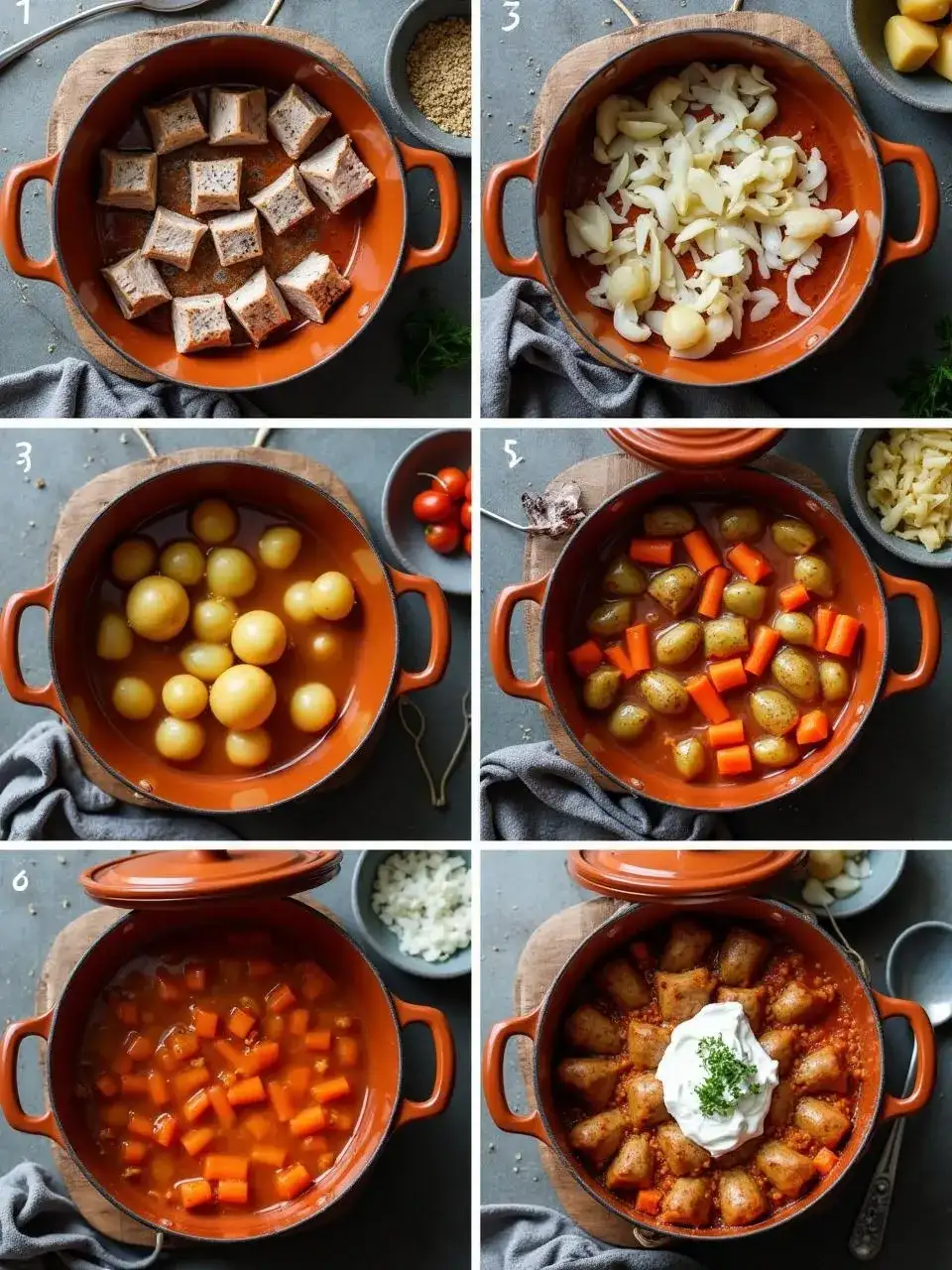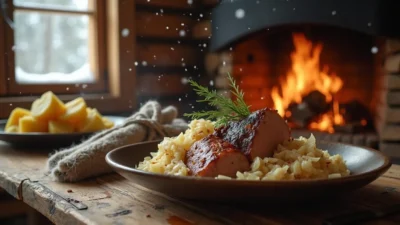Contents
Ingredients
Main Ingredients
- 500 g pork shoulder (or tenderloin/loin), cubed
- Salt, to taste
- Freshly ground black pepper, to taste
- 3 medium potatoes (yellow-fleshed), peeled and diced
- 2 medium carrots, sliced into semi-circles
- 1 large yellow onion, sliced into half rings
- 2 large garlic cloves, minced
- ½ cup tomato puree (or ½ cup tomato juice, reduce stock accordingly)
- 1 ½ cups chicken or pork stock (enough to cover the vegetables)
- 3-4 whole peppercorns per pot (or additional ground black pepper)
- 1 bay leaf per pot
For Serving
- Sour cream or crème fraîche, 1 tbsp per serving
- Fresh parsley (or dill/cilantro), chopped
- Crusty bread (optional)
Instructions
- Preheat the oven to 200°C (390°F). Lightly grease the insides of individual clay pots with olive oil.
- Season cubed pork with salt and pepper. In a pan, heat 2 tbsp of oil over medium-high heat and brown the pork on all sides. Set aside.
- In the same pan, sauté onions for 3–4 minutes. Add garlic and cook for 1 more minute to absorb the pan flavors.
- Layer pork into the bottom of each clay pot. Add carrots and potatoes over the meat. Then top with the onion and garlic mixture.
- Add 1 bay leaf and 3–4 whole peppercorns (or extra black pepper) to each pot.
- Mix the tomato puree with stock in a jug. Pour into the pots until the vegetables are just submerged.
- Cover the pots and bake for 1 hour, or until meat and vegetables are tender.
- Remove from oven, discard bay leaves and peppercorns, and allow to cool for 5–10 minutes.
- Before serving, top each with 1 tablespoon of sour cream and a sprinkle of fresh herbs.
- Serve hot, straight from the pot, with crusty bread if desired.
Notes
 Looking for the perfect cold weather dish? ❄️🍖 Pork chanakhi, known as Čenakai in Lithuania, is a heart-warming clay pot stew that brings old-world charm right into your modern kitchen. With juicy pork, tender potatoes, sweet carrots and savory flavors, this dish is the definition of hearty and nostalgic.
Whether you are looking for a cozy dinner after a long winter walk or want to impress your guests with a rustic Eastern European dish, this pork stew is perfect for everyone.
Looking for the perfect cold weather dish? ❄️🍖 Pork chanakhi, known as Čenakai in Lithuania, is a heart-warming clay pot stew that brings old-world charm right into your modern kitchen. With juicy pork, tender potatoes, sweet carrots and savory flavors, this dish is the definition of hearty and nostalgic.
Whether you are looking for a cozy dinner after a long winter walk or want to impress your guests with a rustic Eastern European dish, this pork stew is perfect for everyone.What is chanakhi?
Chanakhi (ჩანახი) is a traditional Georgian stew usually made with lamb or lamb and cooked over low heat in small clay pots for a rich, deep flavor. Vegetables such as potatoes, tomatoes, and eggplant are added to it and then seasoned with herbs and spices such as khmeli-suneli, a signature Georgian spice blend. But as this dish traveled across Eastern Europe, local variations were born...🇱🇹 Lithuanian chenakai: a delicious adaptation
In Lithuania, chanakhi has acquired a local identity and become chenakai. While the magical clay pot cooking method has remained unchanged, the ingredients reflect Lithuanian flavors and staples. Instead of lamb or beef, Lithuanians prefer pork 🐖, a national favorite. Eggplants are often replaced by carrots, and sour cream is a must-have condiment. What is the result? A dish that seems familiar, homey, and very satisfying.Ingredients (and easy substitutions)
Here's all you need to make authentic-flavored chenakai at home:- Pork shoulder - or substitute with pork tenderloin or loin for a leaner version
- Salt and freshly ground black pepper - for seasoning
- Potatoes - ideally with yellow flesh for a creamier texture
- Carrots - sliced into half rounds Large yellow onion - sliced into half rings
- Garlic cloves - crushed
- Tomato puree - or use ½ cup tomato juice (adjust the amount of broth accordingly) 🍅
- Chicken or pork broth - homemade or store-bought
- Whole peppercorns - or additional ground black pepper
- Bay leaf - one per pot
- Sour cream - or cream, for serving
- Fresh parsley - or use dill or cilantro for flavor 🌿
🔪 Step-by-step instructions
1. Preheat and preparePreheat the oven to 200°C (390°F). Lightly grease the inside of the clay pots with olive oil. 2. Brown the pork
Cut the pork into cubes and season with salt and black pepper. Heat 2 tbsp of neutral oil in a skillet and brown the meat on all sides over medium heat. Set aside when the meat is golden and flavorful. 3. Fry the onion and garlic
In the same skillet, add the onion and cook for 3-4 minutes until slightly softened. Add the garlic and cook for another minute. You will only add flavor, not completely caramelize. 4. Put the ingredients
Start putting directly into the clay pots: First the pork Then the carrots and potatoes Then the onion-garlic mixture Add 1 bay leaf and 3-4 peppercorns per pot 5. Pour in the broth
Mix the broth with the tomato puree in a jug and pour into each pot until the vegetables are barely submerged. 6. Bake over low heat
Cover each clay pot with a lid and place in the oven. Bake for 1 hour, until everything is tender and bubbling. 7. Cool before serving
Take the pots out of the oven, discard the bay leaf and peppercorns and let the stew rest for 5-10 minutes. It's molten and hot, so don't pounce on it right away! 🥵 8. Decorate and serve
Pour a generous spoonful of sour cream over each pot and sprinkle with fresh herbs. Serve straight from the pot with slices of crusty bread 🥖. Bonus tip: Allow each guest to stir their pot before eating. It's part of the magic!
🍽️ How to Serve Chanakhi
Traditionally, chanakhi is served directly from the clay pot in which it is cooked to keep it hot and flavorful. This method adds even more to the experience: steam rises when you lift the lid, cheeks flare from the heat, and the broth bursts with layered flavors. What to serve with?- Rustic sourdough or rye bread
- Light green salad
- Glass of red wine or dark beer 🍷🍺
🧊 Storage and reheating tips
Have leftovers? You are in luck!- Store in an airtight container in the fridge for up to 3 days
- Gently reheat on the stove top over low heat for the best texture
- For a quicker way, heat individual servings in the microwave for 3-4 minutes, stirring halfway through





Ooh, this Chanakhi looks amazing! That sounds so comforting and flavorful – I love the idea of using a clay pot. Can’t wait to try it, especially with that sour cream topping! Definitely adding this to my weekend cooking list.